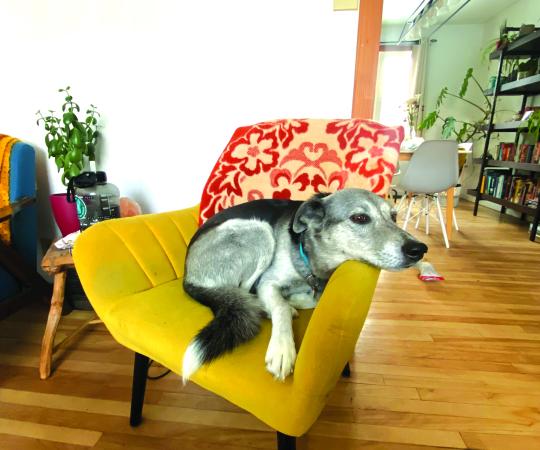Joyce Majiski speaks from a studio on Salt Spring Island in British Columbia, where the Yukon artist has been hard at work for nine months. One hand is on the phone, one eye looking out the window for a sign that the U-Haul is on its way.
“We’re kind of, you know, embroiled in this whole packing and sorting and strategizing how I’m going to get everything in here into the cube van,” says Majiski, her voice brimming with excitement and breathlessness.
Majiski just put the finishing touches on her latest creation. Actually, a recreation—a life-size reconstruction of a juvenile humpback whale made out of ocean-salvaged plastics and Styrofoam. Transporting the 177 hand-carved Styrofoam bones to the Yukon is a delicate operation, although only one of many complex steps to bring life—and a legacy—back to a creature who might have swum a stretch of ocean that includes Glacier Bay.
“She was a young whale. I talked to the biologists and, based on photographs, she was maybe a year or a year and a half,” says Majiski. “I’m hoping she was still with her mom. I’m really emotionally attached to this whale somehow. She was kind of rudely jerked from her life without it being her fault.”
She gave this whale, who drowned in a herring net, a name. “I called her Grace.”
Everything about this project highlights the range of human-initiated threats to ocean habitats. Majiski reconstructed the nine-metre skeleton—including 51 vertebrae—entirely out of multicoloured Styrofoam. The whale’s “skin” will be made from single-use plastic bags, part of a collection Majiski has been gathering, and ironing, for more than a year. The artist, whose previous international work revolved around water and the degradation of seas and oceans by plastic and other waste, painstakingly sketched, carved, and recreated.
The skeleton, suspended from a ceiling with lights, will become part of an immersive, music-infused exhibition, “Song of the Whale,” at the Yukon Arts Centre, scheduled to open in December and run until February 2021.
“I think that it’s going to reach a broader audience than the audience that we normally reach for sure,” says Michi Main, a biologist who, with her husband, a master-bone-articulator, run Cetacea, a company that installs whale skeletons and creates educational programming for museums and science centres. The couple stored the original skeleton of the humpback whale, the one Majiski worked from.
“I feel like the workmanship that has gone into what she’s done, and just the whole concept behind it, for us working right in this field, it’s really inspiring. And, it’s made me also think how else can we do the work that we’re doing to make more of a difference,” says Main, who is now considering the potential of 3D printing, design, and other technologies in their own recreations, especially given the strict rules about working with real bones.
Now safely back home in the Yukon, over the next few weeks Majiski will unpack—consulting her numbered sketches, self-made videos, and the map of Grace, fitting all her pieces together for a dry run.
Majiski has had lots of time to reflect on what she’s recreated. She says the silver lining of the COVID-19 pandemic—if it’s possible to find one—is that it helped her hunker down and sustain her motivation.
“It dovetailed perfectly,” she says. “One of the results of the project that I’m really hoping for is that it becomes a platform for discussion about how we can do things differently, how we can live differently on the planet and use less and just be more cognizant of our effects on nature, and especially in the oceans.”
Cue a global event that forced people to change their lives in drastic ways.
“If you’re trying to advocate for change and people keep saying, ‘We can’t, we can’t, we can’t,’ and then all of a sudden they have to, it’s pretty illustrative of the fact that we can do just about anything we want to if we have to. Or we want to.”










